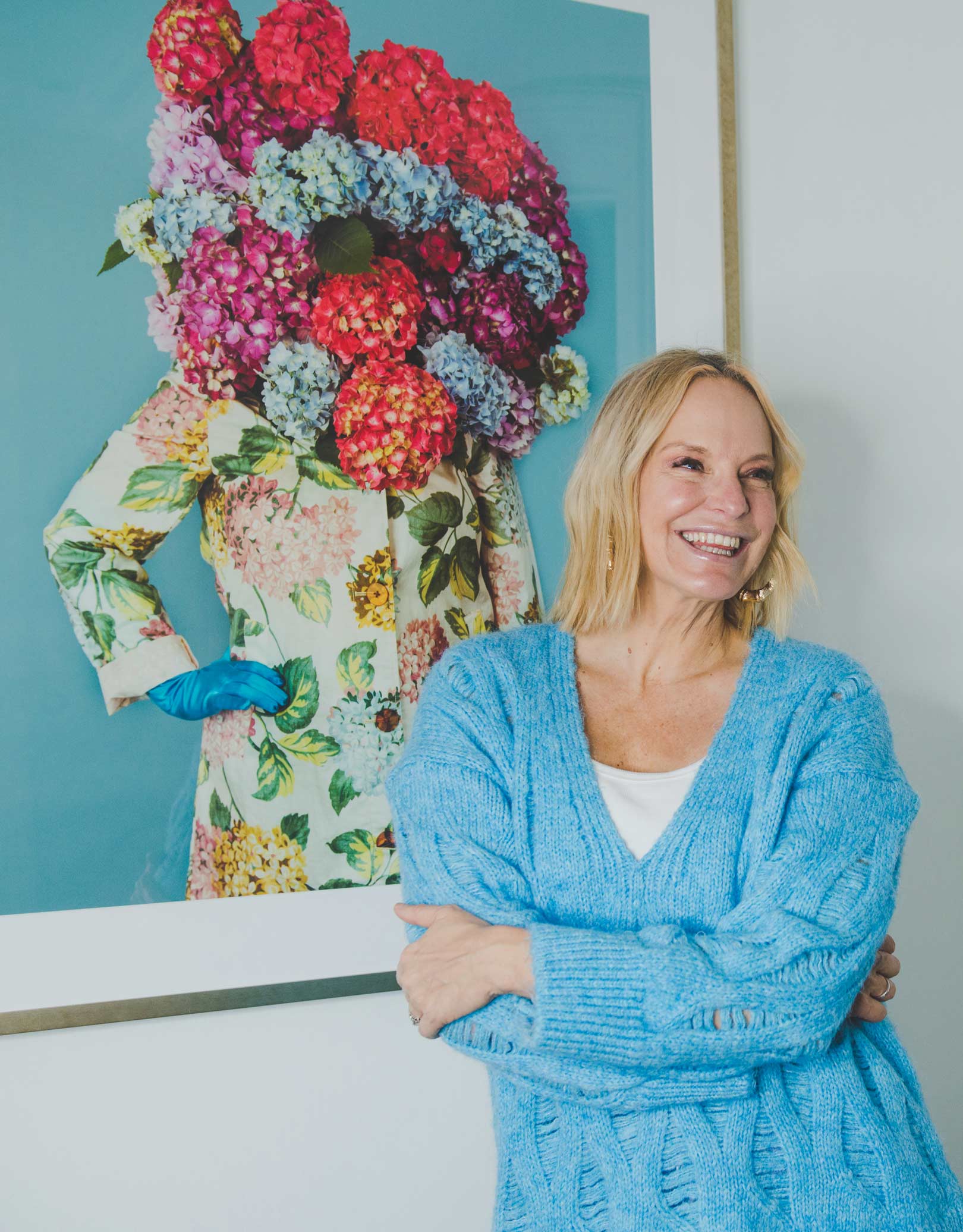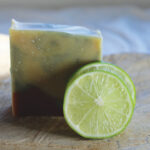
The image-conscious, enigmatic world of fashion has always been fuelled by fantasy, innovation and those who just take pleasure in strutting it. But these days, a new awareness about sustainability is affecting fashion’s landscape, and labels are scrambling to become part of the conversation. Enter Julia Grieve, the 52-year-old statuesque blonde, who’s given herself the moniker of “Accidental Environmentalist,” and who heads up Preloved, a clothing brand she launched in the mid 90s, which pioneered the notion of upcycling.
Julia, who moved to Port Hope from Toronto when her kids started going to Trinity College School, was certainly ahead of her time when it came to New Age sensibilities. It all started when she left high school early to pursue an international modelling career. Though she never earned supermodel status, Julia did find showroom work and fondly recalls the time she had to audition to be a showroom model for Chanel in Japan. “I thrifted an old suit that was sort of like a Jackie O. kind of suit. I changed the buttons and it was really, really tight and I wore it short. And I got the job!” she laughs. This creative play with vintage proved to be a harbinger of things to come.
“I kind of loved this idea of taking vintage and making it just a little bit more modern. Because if you took vintage directly out of a thrift shop, it had a bit of a costume-esque feel to it. It didn’t feel so fashionable on, and I was all about the fashion side of it,” Julia explains. The quality of some of these old clothes impressed her, and her penchant for vintage grew. When she lived in Japan, people were always asking her where she found her vintage pieces, and if they could buy them. That became Julia’s “Aha!” moment, and because she felt homesick for Toronto anyway, she decided to move back to her old stomping grounds and start a business.
“There was no internet. There was no Etsy,” Julia reminisces. “We just rented a small space on Queen West and started thrifting and editing and changing and chopping up. And it was very grungy. Do you remember the days when we totally rocked t-shirts and added studs to them?”
I vividly recall the fabulous sweaters that Julia’s first Preloved label used to turn out, made from deconstructed bits of other sweaters, and everything was one-of-a-kind. But as her business grew, Julia had to figure out ways to be consistent. “We came up with the idea that maybe you actually needed a pattern, so we created patterns. And then we could control it a bit, and we realized it would take two old sweaters to make one new sweater. So now we had a little bit of consistency. That’s what really put ‘Preloved’ on the map – trying to figure ways to come up with consistency in the most inconsistent process: taking vintage and making it new.”
Julia and her team began creating patterns for classic pieces like trench coats and men’s shirts, using vintage fabrics from original pieces to create new garments. Though the fabrications were always a bit different, at least the styles were consistent. “I remember at one point, we were doing such large volumes with 100 percent vintage materials that Anthropology was ordering 1,000 to 1,500 units of one style, and it was all made out of vintage fabric.”
As the business continued to grow, Julia had to change her approach. “One of the problems was that we were very limited in what we could make. It was like, ‘Okay, what can we make out of a dress shirt? What can we make out of a trench coat? What can we make out of denim?’ Trends were changing, and we really wanted to find ways to use fabrics that we were inspired by, not just because they were recycled.” While it was fashion that drove Julia’s ambitions first and foremost, her environmental concerns were growing, so she was determined to create cool fashion that was sustainable. “You really have to create what people want, but then figure out a way to make it sustainable,” she emphasizes. “So we started working with our manufacturers in Scarborough, and we now work with a cotton that is made out of recycled yarn. This was a massive game changer for us.” Julia explains that the fabric itself is new, looks new, and comes on a bolt, just like other fabrics. It also comes in any colour she wants. But the fabrication is made with recycled yarn. “So what you’ll see in our line doesn’t look like vintage at all, because it’s actually not. It’s made out of new fabric. And that new fabric is created out of old yarn.”
Julia’s current clothing line is on fire, and to some degree, she has the pandemic to thank. Covid lockdowns made us all crave comfort and cosiness – and that’s precisely what Julia’s “Preloved” pieces deliver. Working in the sustainable fashion space has also inspired Julia to address other issues of sustainability, and her regular appearances on information shows like CityTV’s Cityline and her website (juliagrieve.ca) have given her a platform to deliver a variety of environmentally friendly lifestyle tips, from what beauty products to use to what to feed your dog. While she realizes that we may still be a long way from saving the planet, at least she’s helping to keep a positive conversation going. “Nothing comes out of naïveté, nothing comes out of fear. Nothing comes out of terrorizing – that’s only going to freeze people,” she says. “We could focus on the fact that the world is ending, and I’m sure there’s so much research on that. But I would much rather focus on the idea that every little bit helps. Yes, sustainability is a huge issue, but at least we’re talking about it now. We weren’t talking about it 10 years ago.”
Julia, her husband Doug Grieve, who works in finance and commutes to Toronto daily, and their three teenage kids live on Port Hope’s historic King Street in one half of the beautiful 6,000 sq. ft. Clemes Duplex, which dates back to 1876. Though the family initially rented the property, they purchased it two years ago and couldn’t be happier. “It is a really beautiful home, actually one of the famous homes in Port Hope. It’s just such a rare building that it’s always part of the house tours, and everyone wants to come and explore it because of the architecture,” says Julia. As charming as life in Port Hope can be, I marvelled at the fact that Julia managed to convince her three kids to move to small-town Ontario after having been raised in the Big Smoke. “Well, they’re certainly all familiar with Toronto. Every house we lived in was close to a subway station, and I loved that feeling. So all the kids grew up very, very, very urban. But now they’re out in Port Hope, and they adore it. They’ve got friends. No one’s in a car, no one’s in an Uber. I know every kid at the party they’re at. And I love that. But at the same time, they’re not scared of big towns at all and like to go on the train. They just go do their life. But they especially love their home in Port Hope, because there’s such a great community of kids here. And it’s not super small – just a really lovely mix. Then again, it’s not too big. It’s all one group of teenagers,” Julia tells me, understandably thrilled that her kids have adjusted to the new lifestyle so well.
With a thriving fashion business under her belt after 28 years, and her own personal “Accidental Environmentalist” brand gaining steam, I wondered just how much further Julia wanted to take her messaging. “Well, I always say if you’re not busy growing, you’re busy dying. I think it’s from a Bob Dylan song. [Actually, it’s “He not busy being born is busy dying.”] But I just love that quote. That’s the truth. When you talk about aging, that’s my message too. You just have to keep learning… Once you start to know everything, that’s when you start to get old. My dad’s 90, and he still has that attitude, trying to learn new things. So that’s always my approach – learning,” Julia states with conviction.
One of the big arenas she’s learning about now is the world of online shopping, which she refers to as “The Wild West,” with all its TikTok algorithms and gargantuan cast of influencers. “That is sort of where we are now, so we’ll focus on that,” she tells me. “I do miss bricks and mortar retail, and I do believe there’s a really good place for interaction in retail… I’m just not sure what that new retail model looks like. But I love it. And I’d like to get back into that.” It’s not surprising to hear that Julia’s harbouring further retail aspirations: Her regular guest appearances on my “Style Matters” show on TSC are always a hit, and proof positive that she really does have a way of connecting with her customers.
Don’t be surprised if Julia plants the seeds for her next project in Port Hope, which she sees as a tiny cultural haven. She’s already talking about setting up a studio space, in which she could do all her shooting. Julia simply adores small town life and likens the experience of living in Port Hope with the way people so often dwell outside major US centres, commuting by train to their jobs in the big cities. “That’s what I love. We travel to downtown Toronto, and I do a lot of work on TV. So I get all that buzz. But then when I drive into my driveway in Port Hope, I’m like, ‘Ahhhh… There’s my neighbour way over there… We’re gonna play tennis next week! And there’s that neighbour way over there… And we’re gonna have dinner at Gusto’s!’ It’s that sophistication that I love.”
Story by:
Jeanne Beker
Photography by:
Jeannette Breward




